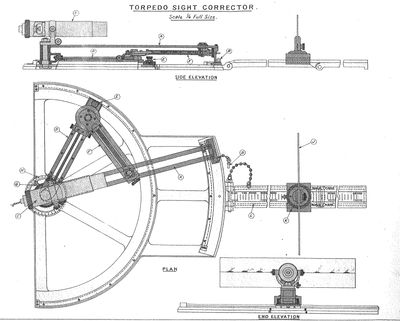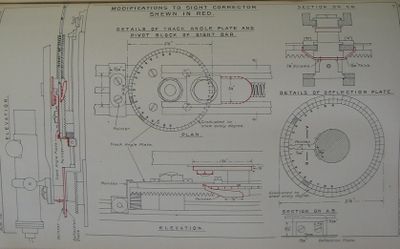Torpedo Sight Corrector: Difference between revisions
No edit summary |
mNo edit summary |
||
| Line 100: | Line 100: | ||
| '''Quantity''' | | '''Quantity''' | ||
|- | |- | ||
|Battery box<br><small>'''Note:''' normally, the 2630 accommodated 8 cells. | |Battery box<br><small>'''Note:''' normally, the 2630 accommodated 8 cells. In this case, packing material should be used to fill the void of 2 missing cells.</small> | ||
| 2630 | | 2630 | ||
| 1 | | 1 | ||
| Line 142: | Line 142: | ||
*{{BibUKARTS1918}} | *{{BibUKARTS1918}} | ||
{{refend}} | {{refend}} | ||
[[Category:Torpedo Control]] | [[Category:Torpedo Control]] | ||
[[Category:Shipboard Equipment]] | [[Category:Shipboard Equipment]] | ||
Revision as of 23:43, 5 November 2011

A Torpedo Sight Corrector was a British apparatus suggested by Lieutenant-Commander W. F. Wake-Walker to demonstrate the effect of director errors for men using the Torpedo Attack Trainer.[2]
Design and Use
The device combined an adapted torpedo director whose various bars could be locked down with a target ship. It would be used after a trial run on the torpedo attack trainer and illustrate, in debrief manner, how the sailor had performed.
A target ship image of appropriate scale for the range in the training scenario at which the sailor had fired, and would be positioned in a suitable inclination to the user. The sight bar is aligned on the target and locked down and the enemy bar set for enemy speed and heading. The torpedo bar would then be locked down and the sight bar unlocked so the enemy bar could then be adjusted to the actual speed and heading of the enemy in the training scenario just undertaken. This causes the sight bar to move, and a spot of light traces the actual place in the enemy line through which the torpedo would have passed.[3]
Allocation
By mid 1919, 110 of these instruments were under manufacture, and some had been received and supplied to ships and bases. The intended allocation (1 each unless otherwise noted) was to be:[4]
| Torpedo Schools | |||
|---|---|---|---|
| Vernon (2) | Defiance | Actaeon | |
| Destroyer depot ships and bases | |||
| Dido (2) | Dover (2) | Port Edgar (2) | Lyness (2) |
| Woolwich | Diligence | Apollo | Blenheim |
| 'Blake | Greenwich | Hecla | Sandhurst |
| Senior Officers of Light Cruiser Squadrons | |||
| Caledon | Carysfort | Cardiff | Birmingham |
| Calliope | Curacoa | Chatham | Lowestoft |
| Light Cruisers and Destroyer Leaders | |||
| Castor | Champion | ||
| Pre-Dreadnoughts | |||
| Lord Nelson | Agamemnon | ||
| Dreadnoughts | |||
| Royal Sovereign | Marlborough | Canada | Dreadnought |
| Royal Oak | Emperor of India | Agincourt | Ramillies |
| Ramillies | Neptune | Resolution | Colossus |
| Revenge | King George V | Hercules | Queen Elizabeth |
| Ajax | St. Vincent | Warspite | Centurion |
| Barham | Erin | Malaya | Orion |
| Collingwood | Valiant | Monarch | Superb |
| Iron Duke | Conqueror | Bellerophon | Benbow |
| Thunderer | Temeraire | ||
| Battlecruisers | |||
| Australia | Indomitable | Hood | Howe |
| Lion | New Zealand | Tiger | Courageous |
| Princess Royal | Renown | Inflexible | Glorious |
| Repulse | |||
| Raleigh class | |||
| Raleigh | Effingham | Hawkins | Frobisher |
| Torpedo carrying aeroplane ship | |||
| Furious | Eagle | Argus | Vindictive |
| Submarine depots and bases | |||
| Titania | Dolphin | Adamant | Forth |
| Lucia | Ambrose | Bonaventure | Thames |
| Fearless | Maidstone | Vulcan | Ithuriel |
| Platypus | Alecto | ||
| Stores to accompany each T.S.C.[7] | ||
|---|---|---|
| Item | Patt. # | Quantity |
| Battery box Note: normally, the 2630 accommodated 8 cells. In this case, packing material should be used to fill the void of 2 missing cells. |
2630 | 1 |
| Receptacle (for 2630?) | 2631 | 1 |
| Battery cell | 3361 | 6 |
| Push | 1918 | 1 |
| Cable | 726 | 12 feet |
| Lamp | 1661 | 2 |
| Connection | 3362 | 5 |
See Also
Footnotes
- ↑ Handbook of Torpedo Control, 1916, Plate 41.
- ↑ Annual Report of the Torpedo School, 1916, p. 34. (A.L. G. 6788/16)
- ↑ Annual Report of the Torpedo School, 1916, p. 34.
- ↑ Annual Report of the Torpedo School, 1918, pp. 228-229.
- ↑ Annual Report of the Torpedo School, 1918, Plate 47.
- ↑ Annual Report of the Torpedo School, 1918, p. 229.
- ↑ Annual Report of the Torpedo School, 1918, p. 229.
Bibliography
